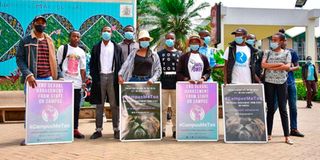#CampusMeToo: What changed after the movement?

Coordinators of CampusMeToo campaign together with student movement's ambassadors at the University of Nairobi in May last year.
What you need to know:
- In 2019, ActionAid surveyed 1,015 students who reported that 66 per cent of the incidents of sexual harassment were committed by a lecturer.
- Students from across public and private universities launched a #CampusMeToo movement in November, 2019 as a result.
One in two female students has been sexually harassed by a staff at the Kenyan universities going by a study widely quoted by ActionAid.
The male are neither spared. One in four of them too, face a similar predicament.
In 2019, ActionAid surveyed 1,015 students who reported that 66 per cent of the incidents of sexual harassment were committed by a lecturer.
Drawing attention was the view of the 38 per cent of the female students and 33 per cent of the male that even if they reported, the respective institutions were unlikely to take the matter seriously.
Policymakers
Faced with this challenge, students from across public and private universities launched a #CampusMeToo movement in November, 2019, to draw the attention of the higher learning institutions, government, policymakers and interested stakeholders to the monster roaming within their boundaries.
Then, 15,000 students signed a petition presented to the Ministry of Education and universities.
They demanded inclusion of mandatory induction sessions for newly enrolled students, training sessions for university staff in terms of prescribed sexual harassment policies, and the appointment of an investigation committee on all campuses that will handle sexual harassment cases.
And according to its spokesperson Rachael Kambura, the movement has borne fruits.
“We are having a significant response from the universities,” she said during a Twitter Spaces organised by Nation Media Group’s Gender Desk, last year.
“From 2019, many universities started to form gender policies and even some incorporated gender officers,” she added.
Although some higher learning institutions already had sexual harassment policies, the movement served as a spark to ignite action against the perpetrators.
It also sensitised the students and empowered them to speak out.
Ms Kambura said they had received encouraging feedback from the students who were prompted by the movement to campaign against the crime in their institutions.
Kenya Medical Training College, for instance, has an elaborate Sexual Harassment Policy dated May 2019.
It enlists gender harassment and sexual bribery as part of the crime of which a student can lodge a formal written and signed complaint through the Dean of Students.
The policy defines gender harassment as generalised sexist statements and behaviour that convey insulting or degrading attitudes about both men and women. This would include insulting remarks, offensive graffiti, obscene jokes or humour about both genders.
While, sexual bribery involves solicitation of sexual activity or other sex-linked behaviour by promise of reward; the proposition may be either overt or subtle.
Violating the policy guarantees an employee the end of his or her services. They would also be barred from accessing its premises. If a student, they would be suspended or expelled. It also considers conciliation as a disciplinary measure.
Sexual harassment is punishable by three years in jail or a fine of not less than Ksh100,000 ($806.78) or to both.





